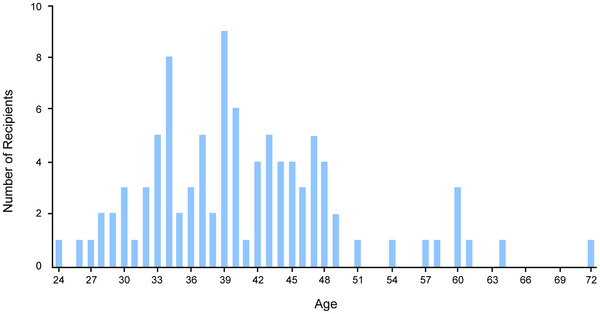As has been noted here numerous times, and by me at various talks, the average age of biomedical researchers getting their first grant from the National Institutes of Health (NIH) in 2008 was 42, a substantial change from even the decade previous. Over the past 30 years, the article notes, the average age of Nobel winners when they performed their research was 41. That's a concern, says Kirstin Matthews, a fellow in science and technology policy at the Baker Institute and first author of the paper in PLoS One.
Well, why? There is no shortage of biomedical research overall but the private sector tends to do most basic research in that area, even though the government has taken over basic research most everywhere else. The contention by government-funded scientists that the corporate world "won't do basic research" has its most glaring exception in biomedicine.
Obviously, you can make a correlation to anything if you find two matching curves, I correlated riots in Arab countries to the price of steel to show how flawed simple curve matching is - so it has to be considered that older researchers are healthier and are retiring later because they continue to do quality research and get funded. That's a science win. There are also far more Ph.D.s each year than can get jobs in academia so some have advocated a quota system for young researchers while others are concerned that if they get it and are then denied at the R01 stage, their careers will be effectively over. Plus, denying a better researcher funding from a limited pool because they are the wrong age is too progressive for scientists to embrace; excellence has to come first.
"This is a bit controversial at a time when we're encouraging more people to get into science," said Matthews, "The gist is that we're dealing with a shrinking NIH budget; at best, we'll get the same budget year to year, adjusted for inflation. So how can we use the money most effectively?"
We don't need to turn more Americans into scientists, academia can't employ more than 16% of them now. I have instead argued we should turn more scientists into Americans by getting rid of Clinton- and Bush-era protectionist work visa schemes so scientists who learn in America are allowed to get jobs rather than being forced to return home where they become competitors to the U.S.
Why did they pin their numbers to the Nobel, though it was certainly an interesting idea? For its reputation and its archives, they said, and because the Nobel Prize is one of the few awards that is consistent. "We were able to get a good pool of laureates (ultimately 96 who won biomed-related Nobels from 1980 to 2010), and they keep great records."

Estimated age distribution of the 96 laureates at time of publication of their Nobel Prize research in biomedicine ranged from 24 to 72. The average age of recipients was 41 and the majority (61%) were under the age of 42, indicating that the distribution was not symmetric and was skewed toward younger investigators. Credit: PLoS One
Often, Matthews said, the Nobel archives even referenced the publications and funding sources at the heart of the winning research, which was vital to their analysis because when someone won was less important than their age when they did their breakthrough research - and who funded it.
But researchers get funding more after a Nobel so it can't be a money issue. They may be arguing that the best work is done by young people but their evidence for that is an indictment of government funding overall, not age; they note anecdotally that when they wrote Nobel laureates about the study, several revealed that their proposals for what ultimately became Nobel-winning research were rejected by NIH committees.
Unless they are claiming the NIH engaged in age discrimination they were simply unconvinced by the proposal - which is another matter entirely. As the government gradually took over academic research, grant writing became more essential. This is less of an issue in the private sector, where most biomedical research is done.
At least in biomedical research, one obvious solution is not to make taxpayers fund more research, it is for academics to stop treating corporate science as some unethical pariah that is creating data for whomever cuts them a check - then we can create more scientists and they can have jobs without burdening taxpayers more. $31 billion in funding is already a lot and America funds more science than any other country.
The argument that young researchers are unqualified to compete in the big world without a quota is vaguely insulting but it would be equally hard to argue that young people don't have bold, new ideas but it all comes back to the root problem; government control of science.
The biggest innovations in the private sector tend to be done by younger people because performance is the only thing that matters; government control of science has led to a raft of paperwork and control issues. Data has shown that young investigators who become insiders in the process have more success - and as mercenary as that sounds, getting government funding is no different than working in the private sector so understanding the system matters - and Matthews agrees, and encourages universities to hone the communication and writing skills of researchers.
Obviously, being the creators of Science 2.0 we couldn't agree more.
Citation: Matthews KRW, Calhoun KM, Lo N, Ho V, 'The Aging of Biomedical Research in the United States', PLoS ONE 6(12): e29738. doi:10.1371/journal.pone.0029738





Comments